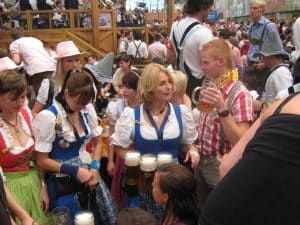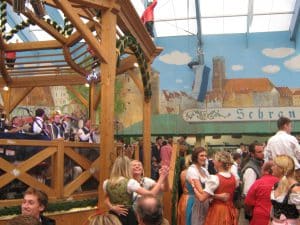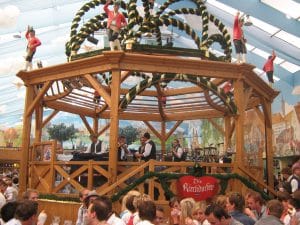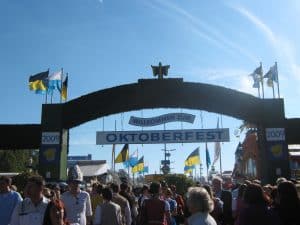Jan-Feb-March-April-Oktober-Nov-Dec
The author explores how the weather gods snipped the “brewing” calendar which fortuitously led to the phenomenon of the Oktoberfestbier
If you were a brewer in 16th century Baviaria you could have had the enviable luxury of a 5 month vacation between April and Oktober. But mind you, not before you’ve had to endure long double-shift workdays in the months of March & April. Just how could a brewer enjoy the privilege of a near-perpetual vacation? Who would then brew when the brewer was away? Well worry not, the answers lie in degree Celcius or Farenheit, take your pick!
As a backdrop, it’s fundamental to understand that beer is a living product since it contains living yeast cells (and sometimes other microorganisms!). In testament to the relativity of things, what we simply call beer is a vast universe for the microscopic living creatures. It was only until a century ago that thermal & filtration related techniques along with some fancy chemistry were applied with the aim of creating stable products. Todays mass produced modern bottled/kegged beers are pasteurised & packed inert thereby killing all the “living” part of beer. These techniques altered the beer landscape unimaginably since they led to the creation of products that were consistent in quality & taste but nevertheless “dead”.
Yeast, the main protagonist in the process of fermenting sugars into alcohol, is quite fussy and works only in limited temperature ranges. The two broad categories of yeast are
- top fermenting yeasts: usually finish fermentation in 3-4 days operating happily between 62 F- 69 F (17 C – 21C), produce estery/fruity flavours.
- bottom fermenting yeasts: take about 10 days to complete fermentation working best between 39F and 48 F (4-9 C), produce fairly clean tasting & crisp beers.

It’s therefore intuitive to conclude that before the advent of refrigeration the former worked best in summer and the latter in winter. Brewers of yore didn’t exactly know this. It wasn’t until the 19th century that brewers, aided by scientific advances in microscopy, would begin to understand the intricate working of yeast and therefore would be able to identify & isolate them to ensure consistency in product. By isolating them and storing them meticulously it was possible to “fix” certain yeast in the recipe which played a major role in ensuring a consistent flavour profile. Different subtypes of yeasts were eventually profiled and today’s brewer has the option of choosing from slew of little creatures wanting to munch on those malt sugars.
However in earlier times brewers had a cursory idea about what yeast did but they could not fathom what exactly it was and how it performed the magic that produced elation (=alcohol). Forget being selective about yeasts the brewers didn’t have control over the type of yeast that beatified their beer. Most times it could be safely assumed that both bottom and top fermented yeasts along with some possibly gate-crashing wild yeast were operating in beer. Obviously yeast strains were a matter of happenstance and would depend to a great extent on the ambient temperatures. Nature played its role: bottom fermenting beers would take prevalence in winters and the top fermenting species ruled the roost during the warmers summer months. But there was a problem in summer a host of other micro-organisms could also find the cozy comfort of beer bubbles in such sultry temperatures. Such unintended infusions of wild strains of yeast and other bacteria would heighten during the hot summer months which made production unreliable. Typically this caused “infections” in beer which made them go sour or develop horrible off flavours. In such weather one could not also dare to store beer for longer time frames since spoilage was accelerated. While it might not be a completely apt example, think about the odd flavour of the jug of milk you accidently left outside the refrigerator after a late night hot-chocolate-driven hunger pang.

Consequently, many European towns had the highest output of beer in springs in the months of March & this dropped through the summer months and then picked up again in November and December. One cannot discount the significance of the invention of refrigeration to beer: refrigeration provided the “invention of the wheel” moment in the life of beer. If refrigeration existed it would have been possible to regulate beer temperature in the range that kept out unwanted micro predators, thereby improving quality and palatability. Further it would have made possible to ferment in either the bottom fermenting or the top fermenting yeast temperature ranges. However much before Mr Linde could work his trick with ammonia, beer and brewing in summer were relegated to being a dubious proposition. To quote an example, the British navy was a huge consumer of beer but they too were troubled as can be garnered from the innumerable instances of the Naval Victualling Dept. receiving letters of complaint about soured beer that had been brewed from May to September.
Although limited by exacting knowledge, brewers and market regulators devised several strategies to overcome the risks of contamination during summer:
-Start work earlier in summer to avoid exposure higher temperatures as the day wore on. In summer it was often necessary to mash-in (dissolve the ground malt in water) at night, when the air was cooler. At Haarlem in Holland for example a typical day of work started at 5:30 a. m. in winter but 4:00 a. m. in the summer. The earlier hour was to keep the beer from being exposed to sunlight and heat.
-Hops do act as a preservative with anti-bacterial properties. Hence it was not uncommon to use higher hop rates in summer in order to enhance keeping qualities. Brewing a stronger beer that could provide more protection by higher alcohol content was a similar strategy.
-Beer according to many town regulations was made to sit in the brewery to make sure that it had been completely fermented before it was left out in the market. But these regulations were relaxed in the summer times. In Amsterdam for instance it was mandatory for beer to sit in the brewery for four days before it could go on the market, but only three days in the warm months of June, July and August.
– Storing beer after production in deep cellars to lower the temperature influence on beer
But the Duke of Bavaria had a more radical solution: a blanket ban on summer brewing. The official brewing season was, therefore, restricted to between St. Michael’s Day (September 29) and St. 



